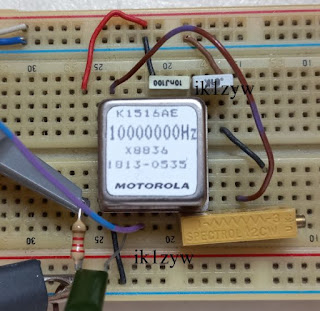This is part 2 of my work on this module. Read part 1 here.
In order to get a usable configuration of the MEMS module described in the previous post, I wired it and started playing with resistors while listening to myself on a pair of headphones since there is enough signal to drive them.
The circuit as-is is so sensitive that it is like wearing a hearing aid!
First of all, it works from 2.5V and up. I noticed no difference in the output quality or volume at higher voltage: the final setup will need to keep the voltage within specifications, i.e. below 4V.
To reduce the overall gain R5 needs to become smaller. That's easy since we can parallel another resistor.
To reduce the microphone sensitivity I need an higher R6, so the original 0 ohm must be removed.
I chose to use 10k trimpot to speed up the process of finding a suitable configuration and started with R6. Rather than desoldering I cut it away. While increasing R6 has some effect on the sensitivity, the circuit starts humming when begins a noticeable reduction in the sound picked up.
I chose to keep R6 at zero ohm for now and moved on to R5. In this case the trimpot is in parallel to the existing 222 (22k) resistor since we need a lower resistance to decrease the gain. When the gain is adjusted it's like acting on a volume control, so both voice and hiss decrease of the same amount.
Fine, time to act again on the microphone gain R6. This time I kept leads short and fit first 330 ohm then 5600 ohm. In both cases I could notice the decrease in sensitivity but the noise/hiss was unchanged.
I will not spend more time debugging this module. It does work, it is very sensitive, but it is noisy. The noise might come from the op-amp or the MEMS module itself. Regardless, this circuit cannot be satisfactorily used with a transmitter. Maybe a different batch could yield different results, who knows.
Other uses? Probably recording sound that is then post-processed to remove the hiss is possible. I leave the comments open (moderated) so that readers can share their stories with this module.




